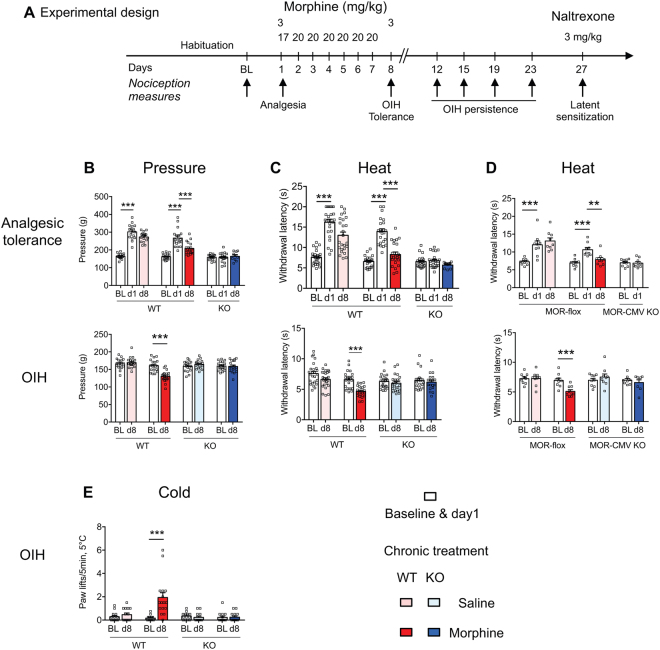Figure 1.
WT but not MOR KO mice show hyperalgesia under repeated morphine analgesic tolerance conditions. (A) The experimental design shows the schedule for nociceptive measures (arrows). Following baseline (BL), mice received 3 mg/kg morphine (ip) on day-1 (d1) to evaluate morphine-induced analgesia. Mice received thereafter 20 mg/kg morphine or saline control each day until day-7 (d7). On d8, nociceptive levels were measured before morphine administration to evaluate hyperalgesia, and following 3 mg/kg morphine to measure analgesic tolerance. Maintenance of hyperalgesia (OIH) was scored on the indicated days and latent sensitization on day 27. (B) Tail pressure (n = 18–19/group) and (C) tail immersion (48 °C, n = 19–25/group) results show analgesic tolerance (upper panels) in WT mice with repeated morphine. Pressure and heat hyperalgesia in WT but not KO mice are shown with the same mouse groups in bottom panels. **p < 0.01; ***p < 0.001 compared to baseline or d1. (D) Analgesic tolerance and hyperalgesia occur in MOR-flox but not MOR-CMV mice. **p < 0.01; ***p < 0.001 compared to baseline or to d1 (tail immersion 48 °C, n = 8–9/group). Two-way repeated ANOVA, Newman-Keuls test. (E) WT but not MOR KO mice show cold allodynia under morphine analgesic tolerance conditions. Following baseline (BL) cold response scoring on the 5 °C cold plate, mice received 20 mg/kg morphine or saline control once a day until day 7 as described in (A) and paw responses to cold were measured to evaluate cold allodynia. n = 13–16/group. ***p < 0.001 compared to BL. ANOVA repeated measures, Newman-Keuls test. Detailed statistical analyses are presented in Supplementary Table S2.

